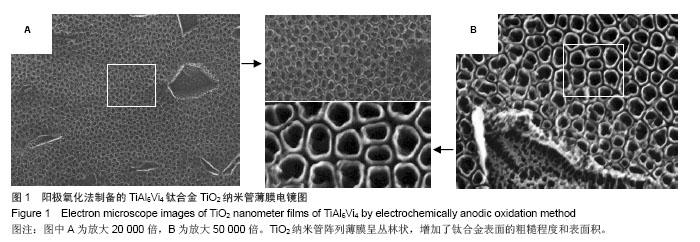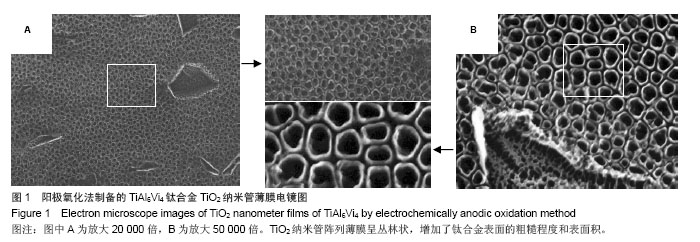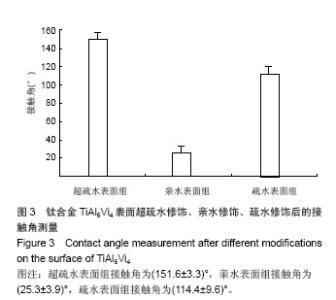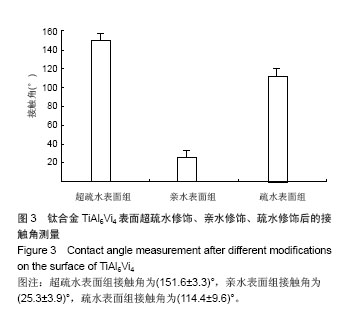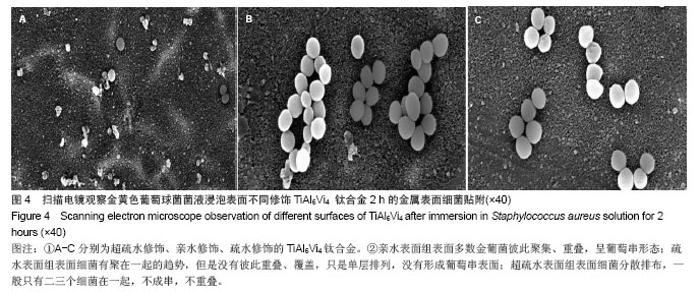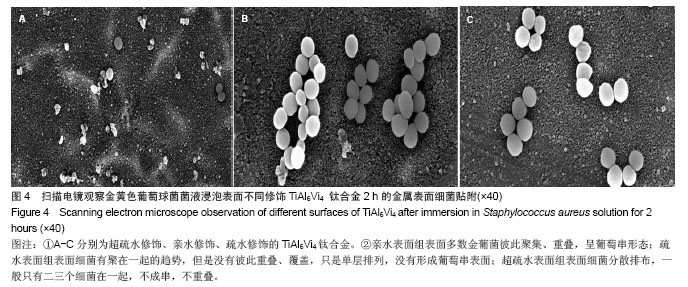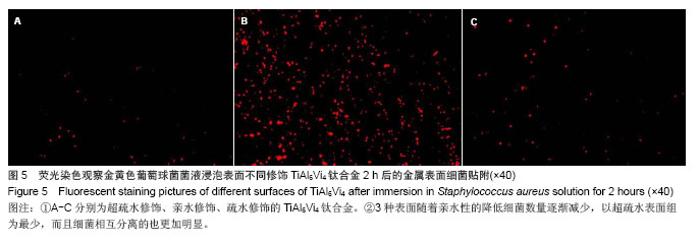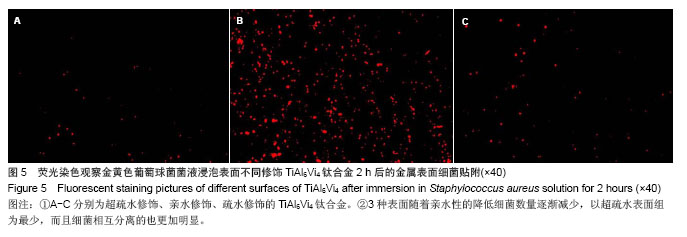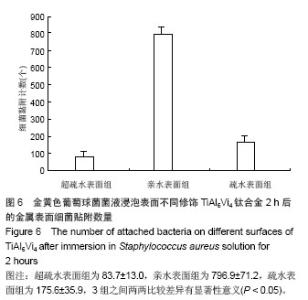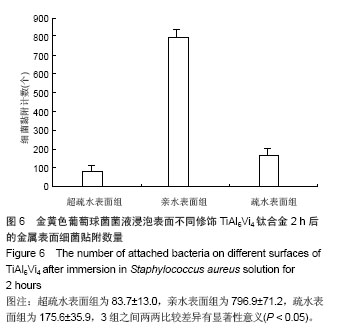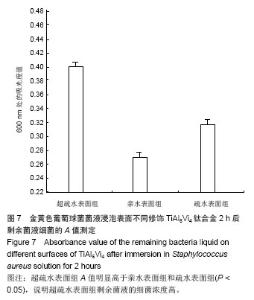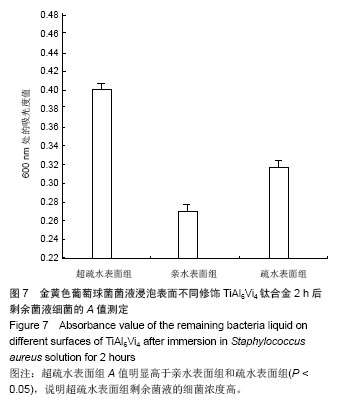Chinese Journal of Tissue Engineering Research ›› 2014, Vol. 18 ›› Issue (21): 3322-3328.doi: 10.3969/j.issn.2095-4344.2014.21.008
Previous Articles Next Articles
Modification of superhydrophobic surface of TiAl6Vi4 and its bacteriostatic action in vitro
Zhang Wei, Zhang Li-cheng, Zhang Li-hai, Wei Jun-qiang, Tang Pei-fu
- Department of Orthopaedics, General Hospital of Chinese PLA, Beijing 100853, China
-
Online:2014-05-21Published:2014-05-21 -
Contact:Tang Pei-fu, Chief physician, Professor, Doctoral supervisor, Department of Orthopaedics, General Hospital of Chinese PLA, Beijing 100853, China -
About author:Zhang Wei, M.D., Attending physician, Department of Orthopaedics, General Hospital of Chinese PLA, Beijing 100853, China -
Supported by:the Nursery Foundation for Science and Technology Innovation in PLA General Hospital, No. 13KMM11
CLC Number:
Cite this article
Zhang Wei, Zhang Li-cheng, Zhang Li-hai, Wei Jun-qiang, Tang Pei-fu . Modification of superhydrophobic surface of TiAl6Vi4 and its bacteriostatic action in vitro[J]. Chinese Journal of Tissue Engineering Research, 2014, 18(21): 3322-3328.
share this article
| [1]Williams D.The golden anniversary of titanium biomaterials.Med Device Technol. 2001;12(7):8-11. [2]Ferguson SJ,Langhoff JD,Voelter K,et al.Biomechanical comparison of different surface modifications for dental implants.Int J Oral Maxillofac Implants. 2008;23(6): 1037-1046. [3]Vadillo-Rodriguez V,Bruque JM,Gallardo-Moreno AM,et al.Surface-dependent mechanical stability of adsorbed human plasma fibronectin on Ti6Al4V: domain unfolding and stepwise unraveling of single compact molecules. Langmuir : the ACS journal of surfaces and colloids.2013;29(27): 8554-8560. [4]Zhao Y,Wong SM,Wong HM,et al.Effects of carbon and nitrogen plasma immersion ion implantation on in vitro and in vivo biocompatibility of titanium alloy. ACS Appl Mater Interfaces. 2013;5(4):1510-1516. [5]Fischer U,Hempel U,Becker D,et al.Transforming growth factor beta1 immobilized adsorptively on Ti6Al4V and collagen type I coated Ti6Al4V maintains its biological activity. Biomaterials.2003;24(15):2631-2641. [6]Leventhal GS.Titanium, a metal for surgery. J Bone Joint Surg Am.1951;33-a(2):473-474. [7]De Nardo L,Raffaini G,Ebramzadeh E,et al.Titanium oxide modeling and design for innovative biomedical surfaces: a concise review.Int J Artif Organs.2012;35(9):629-641. [8]Murr LE,Quinones SA,Gaytan SM,et al.Microstructure and mechanical behavior of Ti-6Al-4V produced by rapid-layer manufacturing, for biomedical applications. J Mech Behav Biomed Mater.2009;2(1):20-32. [9]Minagar S,Wang J,Berndt CC,et al. Cell response of anodized nanotubes on titanium and titanium alloys.J Biomed Mater Res A.2013;101(9):2726-2739. [10]Abdel-Hady Gepreel M,Niinomi M.Biocompatibility of Ti-alloys for long-term implantation.J Mech Behav Biomed Mater.2013; 20:407-415. [11]Vanderleyden E,Mullens S,Luyten J,et al.Implantable (bio)polymer coated titanium scaffolds: a review.Curr Pharm Des.2012;18(18):2576-2590. [12]Saharudin KA,Sreekantan S,Abd Aziz SN,et al.Surface modification and bioactivity of anodic Ti6Al4V alloy.J Nanosci Nanotechnol.2013;13(3):1696-1705. [13]Niinomi M,Nakai M,Hieda J.Development of new metallic alloys for biomedical applications. Acta Biomaterialia. 2012; 8(11):3888-3903. [14]Hanawa T.A comprehensive review of techniques for biofunctionalization of titanium.J Periodontal Implant Sci. 2011;41(6):263-272. [15]Nakai M,Niinomi M,Akahori T,et al.Development of biomedical porous titanium filled with medical polymer by in-situ polymerization of monomer solution infiltrated into pores.J Mech Behav Biomed Mater.2010;3(1):41-50. [16]Yilmazer H,Niinomi M,Nakai M,et al.Heterogeneous structure and mechanical hardness of biomedical beta-type Ti-29Nb-13Ta-4.6Zr subjected to high-pressure torsion.J Mech Behav Biomed Mater.2012;10:235-245. [17]Niinomi M,Nakai M,Akahori T.Frictional wear characteristics of biomedical Ti-29Nb-13Ta-4.6Zr alloy with various microstructures in air and simulated body fluid. Biomed Mater. 2007;2(3):S167-174. [18]Nakai M,Niinomi M,Ishii D.Mechanical and biodegradable properties of porous titanium filled with poly-L-lactic acid by modified in situ polymerization technique. J Mech Behav Biomed Mater.2011;4(7):1206-1218. [19]Tanaka Y,Matsuo Y,Komiya T,et al.Characterization of the spatial immobilization manner of poly(ethylene glycol) to a titanium surface with immersion and electrodeposition and its effects on platelet adhesion.J Biomed Mater Res A.2010; 92(1):350-358. [20]Nowicka J,Bartoszewicz M,Gosciniak G.[Effect of selected properties of Staphylococcus epidermidis to biofilm formation on orthopedic implants]. Med Dosw Mikrobiol. 2012;64(3): 189-196. [21]Ji J,Zhang W. Bacterial behaviors on polymer surfaces with organic and inorganic antimicrobial compounds.J Biomed Mater Res A.2009;88(2):448-453. [22]Raulio M,Jarn M,Ahola J,et al. Microbe repelling coated stainless steel analysed by field emission scanning electron microscopy and physicochemical methods.J Ind Microbiol Biotechnol.2008;35(7):751-760. [23]Okada A,Nikaido T,Ikeda M,et al.Inhibition of biofilm formation using newly developed coating materials with self-cleaning properties. Dent Mater J. 2008;27(4):565-572. [24]Huan Z,Fratila-Apachitei LE,Apachitei I,et al. Porous TiO? surface formed on nickel-titanium alloy by plasma electrolytic oxidation: a prospective polymer-free reservoir for drug eluting stent applications.J Biomed Mater Res B Appl Biomater. 2013;101(5):700-708. [25]Antoci V Jr,Adams CS,Hickok NJ,et al.Vancomycin bound to Ti rods reduces periprosthetic infection: preliminary study.Clin Orthop Relat Res.2007;461:88-95. [26]Neogi DS,Yadav CS,Khan SA,et al.In vivo efficacy of antimicrobial-coated devices. J Bone Joint Surg.2008; 90(8): 1785; author reply 1785-1786. [27]An YH,Stuart GW,McDowell SJ,et al. Prevention of bacterial adherence to implant surfaces with a crosslinked albumin coating in vitro.J Orthop Res.1996;14(5):846-849. [28]Arciola CR,Radin L,Alvergna P,et al.Heparin surface treatment of poly(methylmethacrylate) alters adhesion of a Staphylococcus aureus strain: utility of bacterial fatty acid analysis.Biomaterials.1993;14(15):1161-1164. [29]Chandy T,Sharma CP.Chitosan--as a biomaterial. Biomater Artif Cells Artif Organs. 1990;18(1):1-24. [30]Chandy T,Sharma CP.Chitosan matrix for oral sustained delivery of ampicillin. Biomaterials.1993;14(12):939-944. [31]Wassall MA,Santin M,Isalberti C,et al.Adhesion of bacteria to stainless steel and silver-coated orthopedic external fixation pins.J Biomed Mater Res.1997;36(3):325-330. [32]Dell'Acqua G,Giacometti A,Cirioni O,et al.Suppression of drug-resistant Staphylococcal Infections by the quorum-sensing inhibitor RNAIII-inhibiting peptide. J Infect Dis.2004;190(2):318-320. [33]Lerebour G,Cupferman S,Bellon-Fontaine MN.Adhesion of Staphylococcus aureus and Staphylococcus epidermidis to the Episkin reconstructed epidermis model and to an inert 304 stainless steel substrate.J Appl Microbiol.2004;97(1):7-16. [34]Lafuma A,Quéré D.Superhydrophobic states. Nat Mater.2003; 2(7):457-460. [35]Lewis K. Persister cells, dormancy and infectious disease. Nature reviews. Microbiology. Jan 2007;5(1):48-56. [36]Bernhardt R,Scharnweber D,Muller B,et al.Comparison of microfocus- and synchrotron X-ray tomography for the analysis of osteointegration around Ti6Al4V implants.Eur Cell Mater.2004;7:42-51; discussion 51. [37]Bernhardt R,Kuhlisch E,Schulz MC,et al.Comparison of bone-implant contact and bone-implant volume between 2D-histological sections and 3D-SRµCT slices.Eur Cell Mater.2012;23:237-247;discussion 247-248. [38]Shalabi MM,Wolke JG,Cuijpers VM,et al.Evaluation of bone response to titanium-coated polymethyl methacrylate resin (PMMA) implants by X-ray tomography.J Mater Sci Mater Med.2007;18(10):2033-2039. [39]Kiba H,Hayakawa T,Oba S,et al.Potential application of high-resolution microfocus X-ray techniques for observation of bone structure and bone-implant interface.Int J Oral Maxillofac Implants.2003;18(2):279-285. [40]Cancedda R,Cedola A,Giuliani A,et al.Bulk and interface investigations of scaffolds and tissue-engineered bones by X-ray microtomography and X-ray microdiffraction. Biomaterials. 2007;28(15):2505-2524. |
| [1] | Li Xingping, Xiao Dongqin, Zhao Qiao, Chen Shuo, Bai Yiguang, Liu Kang, Feng Gang, Duan Ke. Preparation and properties of copper-loaded antibacterial functional film on titanium surface [J]. Chinese Journal of Tissue Engineering Research, 2021, 25(4): 553-557. |
| [2] | Shi Xiaoxiu, Mao Shilong, Liu Yang, Ma Xingshuang, Luo Yanfeng. Comparison of tantalum and titanium (alloy) as orthopedic materials: physical and chemical indexes, antibacterial and osteogenic ability [J]. Chinese Journal of Tissue Engineering Research, 2021, 25(4): 593-599. |
| [3] | Zhang Xianjun, Zhao Xijiang. In vivo osteogenic properties of silicon-incorporated titanium dioxide nanotubes on titanium screw surface [J]. Chinese Journal of Tissue Engineering Research, 2021, 25(16): 2461-2465. |
| [4] | Liu Zige, Liu Xinrui, Li Yan, Song Guorui, Zhang Chen, Chen Desheng. In vitro experiment of tetrandrine on the model of osteolysis induced by wear particles around the prosthesis [J]. Chinese Journal of Tissue Engineering Research, 2021, 25(15): 2358-2363. |
| [5] | Wu Shengxiang, Liu Yuan, Lu Shuai. Mini-locking titanium plate system fixation in the treatment of carpal scaphoid fracture [J]. Chinese Journal of Tissue Engineering Research, 2021, 25(12): 1874-1878. |
| [6] | Zhang Lixing, Tian Ang, Li Xi, Bai Xizhuang. Drug-release characteristic and biological toxicity of TiO2 nanotube/hydroxyapatite loaded vancomycin coating [J]. Chinese Journal of Tissue Engineering Research, 2021, 25(10): 1500-1506. |
| [7] | Gu Yuanping, Lu Chenghui . Cleaning efficacy of two kinds of mechanical nickel-titanium instruments in preparation of severely curved root canals: a scanning electron microscopic study [J]. Chinese Journal of Tissue Engineering Research, 2021, 25(10): 1566-1570. |
| [8] | Ma Jinchao, Liu Tiansheng, Liu Aipeng, Wang Hao, Wang Qi, Liang Yongjian, Wang Lin, Di Haiwei. Photodynamic antimicrobial chemotherapy for repairing a rabbit model of osteomyelitis [J]. Chinese Journal of Tissue Engineering Research, 2020, 24(8): 1254-1259. |
| [9] | Liu Chundong, Shen Xiaoqing, Zhang Yanli, Zhang Xiaogen, Wu Buling. Effects of strontium-modified titanium surfaces on adhesion, migration and proliferation of bone marrow mesenchymal stem cells and expression of bone formation-related genes [J]. Chinese Journal of Tissue Engineering Research, 2020, 24(7): 1009-1015. |
| [10] | Yang Xu, Zhao Xiaofeng, Qi Detai, Wang Xiaonan, Jin Yuanzhang, Zhou Runtian, Zhao Bin. Changes in cervical sagittal balance after three-dimensional printing ACT titanium cage in anterior cervical discectomy with fusion [J]. Chinese Journal of Tissue Engineering Research, 2020, 24(36): 5741-5748. |
| [11] | Zhang Hui, Xu Nanwei, Nong Luming, Tang Xueming, Zhou Xindie, Jiang Wei. Factors influencing the prognosis of central cord syndrome treated with drug therapy and titanium plate fixation [J]. Chinese Journal of Tissue Engineering Research, 2020, 24(3): 348-353. |
| [12] | Yang Xiao, Mei Wei, Zhang Wei. Absorbable rod or titanium alloy screws for Mason type II radial head fractures [J]. Chinese Journal of Tissue Engineering Research, 2020, 24(27): 4328-4332. |
| [13] |
Zhang Xuan, Li Yunpeng, Zhang Xuejian, Yin Chuanrong, Deng Yue.
Guided bone regeneration using preformed titanium mesh combined with bioabsorbable membranes in aesthetic area [J]. Chinese Journal of Tissue Engineering Research, 2020, 24(26): 4112-4117. |
| [14] | Zhang Lan, Wang Xiang, Liu Jun, Zhang Chunqiu, Ye Jinduo, Liu Lu. Tensile properties of three-dimensional printed porous titanium alloy trabecular bone [J]. Chinese Journal of Tissue Engineering Research, 2020, 24(22): 3498-3503. |
| [15] | Wang Yanling, Shao Zhe, He Wei. Micro-arc oxidation and osteoblast proliferation and osteogenic differentiation ability on titanium surface [J]. Chinese Journal of Tissue Engineering Research, 2020, 24(22): 3486-3490. |
| Viewed | ||||||
|
Full text |
|
|||||
|
Abstract |
|
|||||
